Abstract
An improved re-entrant negative Poisson’s ratio metamaterial based on a combination of 3D printing and machining is proposed. The improved metamaterial exhibits a superior load-carrying and vibration isolation capacity compared to its traditional counterpart. The bandgap of the proposed metamaterial can be easily tailored through various assemblies. Additionally, particle damping is introduced to enhance the diversity of bandgap design, improve structural damping performance, and achieve better vibration isolation at low and medium frequencies. An experiment and simulation were conducted to assess the static and vibration performances of the metamaterial, and consistent results were obtained. The results indicate a 300% increase in the bearing capacity of the novel structure compared to traditional structural metamaterials. Furthermore, by increasing the density of metal assemblies, a vibration-suppressing bandgap with a lower frequency and wider bandwidth can be achieved. The introduction of particle damping significantly enhanced the vibration suppression capability of the metamaterial in the middle- and low-frequency range, effectively suppressing resonance peaks. This paper establishes a vibration design method for re-entrant metamaterials, which is experimentally validated and provides a foundation for the vibration suppression design of metamaterials.
1. Introduction
Metamaterials are artificially designed materials with periodic lattice arrangements, exhibiting advanced mechanical and physical properties that surpass those found in natural materials, such as mechanics [1,2], acoustics [2,3,4,5,6], and electromagnetics [7,8]. Notably, negative Poisson’s ratio (NPR) metamaterials have garnered widespread attention in fields like aerospace due to their remarkable properties, including a negative Poisson’s ratio [9,10,11,12,13,14,15], negative stiffness [16,17,18,19,20], and negative thermal expansion coefficient [21,22,23].
In the mechanical application of metamaterials, the deformation behavior, bearing capacity, and the ability to resist vibration and impact have always been the research focuses. Zhang et al. [24] investigated the influence of hierarchical structures on bandgap distribution and energy absorption efficiency, revealing significant potential in widening bandgaps and enhancing energy absorption efficiency. Li et al. [25] proposed novel face-centered cubic plate and truss micro-lattices as new types of metamaterials and found that the absorption coefficient’s characteristics are fundamentally shaped by the geometric morphology of voids and cavities. The exceptional mechanical performance stems from the near-membrane stress state of the plate structures and the superior ductility and strength of the base material. Chen et al. [26] theoretically and numerically studied the dynamic behavior of triangular and hexagonal lattice cylindrical structures under constant-velocity impact. The results showed that for lattice cylindrical shells, introducing a positive density gradient can enhance early-stage energy absorption at high velocities. For lattice sandwich cylindrical shells, introducing a density gradient can effectively reduce the peak fracture force but has minimal impact on energy absorption. Guo et al. [27] demonstrated that the deformation behavior of expandable lattice cylindrical shells can be represented by NPR modes, while the different deformation behaviors of lattice sandwich cylindrical shells (e.g., “Z” mode, circular mode, diamond mode, and mixed mode) are primarily determined by the proportions of the core material. Moeini et al. [28] rigorously validated and confirmed the numerical and analytical homogenization of honeycomb structures with high relative densities and varying representative unit quantities. Moscatelli et al. [29] highlighted the existence of bandgaps at relatively low frequencies in periodic locally resonant materials (LRM), which can be utilized for vibration attenuation or shock absorption. Meng et al. [30] analyzed the equivalent mechanical behavior and bandgap characteristics of star-shaped honeycomb structures, and the numerical results showed that a negative Poisson’s ratio provides an enhanced effective Young’s modulus for the considered honeycomb structure. When the Poisson’s ratio is negative, the bandgap exists at much lower frequencies, and the cumulative bandgap width remains constant. Mukherjee et al. [31] proposed a novel honeycomb lattice geometric shape that combines seamless arrangements of a traditional core and an expandable core, offering significant advantages in tuning high-frequency bandgap behavior. All of these works show that metamaterials have good application potential in aerospace, and the rational design of artificial micro-structured metamaterials with advanced mechanical and physical properties that are not accessible in nature is challenging and important. Li et al. [32] investigated the existence of Minnaert resonance in three-dimensional systems and found that weak resonance always occurs with appropriately chosen parameters, and enhanced or even strong resonance can be achieved through geometric shape selection. Nitish et al. [33] proposed a single-phase acoustic metamaterial composed of periodically arranged divergent star-shaped units that exhibit low-frequency and wide bandgaps and validated it by experimental research. To achieve significant tunable bandgaps in conventional rigid materials, Wang et al. [34] proposed a novel metamaterial with the use of soft materials and granular systems, which can avoid excessive pre-stress and enhance tunable phononic crystals. Utal et al. [35] developed a gradient-based topology optimization method to maximize the bandgap width and demonstrated successful application in achieving wide bandgaps in a sample case. Additionally, Zeeshan et al. [36] demonstrated that the magneto-tunability of phononic bandgaps in a periodic hard-magnetic soft laminated composite and found that the first bandgap width was maximized when the volume fraction of the hard phase exceeded that of the soft phase. Furthermore, Alam et al. [37] designed highly nonlinear isolators and diodes for the clean separation of highly deformable solitary waves by using highly deformable metamaterials.
As a material that can be designed artificially, metamaterials show potential advantages in the regulation and optimization of various mechanical and physical properties. Khajeh-Khalili et al. have done much work on the regulation and optimization of metamaterials [38,39,40]. They proposed a novel unit cell configuration composed of two periodic locally resonant peace-logo planar metamaterial (PLPM) patterns, which can control the coupling and resonant frequency by the rotation of the bottom PLPM pattern. Moreover, Khajeh-Khalili et al. also proposed metamaterial structures to enhance the gain and reduce the mutual coupling of microstrip multiple-input multiple-output (MIMO) antennas. By vertically embedding modified peace-logo planar metamaterial (MPLPM) structures into the antenna substrate, the directivity and gain of the antenna can be increased, and placing two-sided MPLPM (TSMPLPM) structures between the antenna elements can improve isolation. Moreover, in their work, a millimeter-wave power divider (MWPD) was introduced, achieving high isolation in the millimeter-wave frequency range, specifically for mmWave applications, such as 5G, without the need for isolation resistors. Liang et al. [41] proposed and verified a systematic inverse design framework for constructing multi-stable mechanical metamaterials with programmable gradients, and offered a new paradigm for developing precisely tailored and programmable mechanical metamaterials. Tayaallen et al. [42] proposed a multi-layered symmetric metamaterial design for C- and X-band applications, and the proposed metamaterial design accomplished the miniaturization concept by arranging unit cells in a multi-layer structure and possesses unique properties, such as a highly effective medium ratio and left-handed characteristics.
It is evident that metamaterials possess a higher degree of designability compared to traditional materials, and incorporating assembly techniques into metamaterial design can enhance their versatility and designability. As a class of artificially designed materials, metamaterials offer significant advantages in structural lightweight while simultaneously addressing various other performance requirements. In the aerospace applications of metamaterials, there are three main requirements that need to be met simultaneously: structural lightweight requirements, adequate strength and stiffness, and good vibration properties. Extensive research has been conducted in this area.
This work presents an assembly-based approach to design a re-entrant negative Poisson’s ratio metamaterial by introducing circular rings as connecting nodes to conventional NPR metamaterials and a 300% increase in the bearing capacity of the novel structure compared to traditional structural metamaterials. The introduction of the metal pins and metal particles increases the density of the metamaterial structure, so the resonance frequencies of the overall structure will move in the low-frequency direction, and the corresponding resonant vibration amplitude may indeed be larger than that of the original structure, which can be suppressed by damping. Meanwhile, the vibration suppression bands will also move, and the vibration propagation can be suppressed by making the suppression band contain the frequency of the vibration source. The resonance frequency of the overall structure of the metamaterials can be adjusted by the mass of the particle damping, the amplitude of the resonance peak can be suppressed by the particle damping, and the damping energy consumption effect can also suppress the vibration of other frequencies. On the other hand, in the medium- and high-frequency bands, the bandgap properties of the metamaterial can be adjusted by regulating the mode of the metamaterial cells through an increase in the particle mass or metal pins. In summary, by introducing metal pins and particle damping, the structural bandgap and the overall mode frequency can be adjusted, and vibration control can be realized. The improvement of the carrying capacity and vibration suppression capacity is conducive to the application of negative Poisson’s ratio metamaterials in automotive, aerospace, and other engineering fields. The design scheme presented in this paper is expected to be applied in the design of space equipment.
In this paper, Section 2 introduces the structural characteristics and design principles of the re-entrant negative Poisson’s ratio metamaterial. Section 3 presents the static mechanical performance under different assembly conditions. Section 4 investigates the bandgap characteristics of the metamaterial under different assembly conditions, along with methods for bandgap control. Additionally, particle damping is introduced to suppress low-frequency vibration, and the effect of particle damping on the bandgap characteristics is examined. Section 5 validates the vibration isolation performance of the metamaterial by using simulation and experimental methods, with a focus on the increased suppression of low-frequency vibration due to particle damping.
2. Geometrical Configuration of the Novel Re-Entrant Metamaterials
As shown in Figure 1, a novel NPR metamaterial (N-NPRM) is constructed by introducing a ring structure into the traditional NPR metamaterial (T-NPRM); the joint of the thin walls is replaced by the ring structure. The geometric parameters of the N-NPRM are listed in Table 1. L1 and L2 are the width and length of the unit cell, T is the thickness of the thin wall, θ is the angle between the thin walls, and R is the radius of the hole. The N-NPRM and T-NPRM have the same width and length of the unit cell.
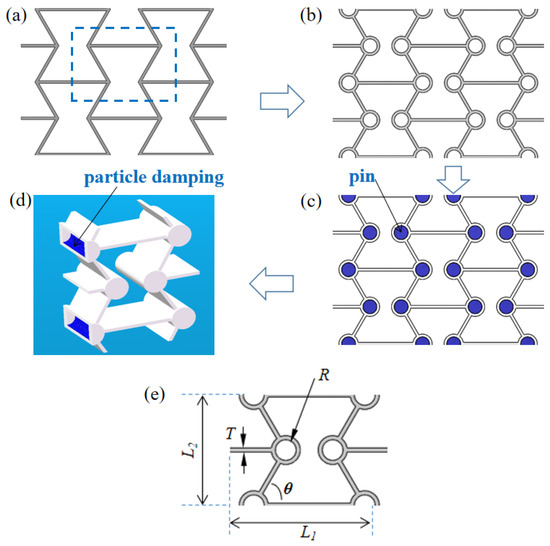
Figure 1.
Schematic diagrams of (a) T-NPRM, (b) N-NPRM, (c) N-NPRM with pins, and (d) N-NPRM with particle damping. (e) Geometrical parameters of N-NPRM.

Table 1.
Geometrical dimensions of the unit cell.
3. Mechanical Properties of the Proposed NPRM
The proposed NPRM is manufactured by 3D-printing technology, and made of a polymer plastic material named WEILAI 8000, which is from a company named WeNext (Shenzhen, China). The pieces at both ends are made of aluminum, the assembly pins are made of metal, and the particle damping comprises tungsten particles. The properties of the material are listed in Table 2.

Table 2.
The material properties.
A simulation and experiment were conducted to study the mechanical properties of the NPRM. The testing method is shown in Figure 2. Specifically, for the equivalent setup of particle damping in the simulation, the loose particles were considered to have no impact on the structural stiffness and to only affect the mass distribution at the locations of the connecting circular rings. Therefore, in the finite element analysis, the circular rings were separately segmented, and their material properties, except for density, were the same as that of the plastic (WL8000). The equivalent density can be obtained using the following formula:
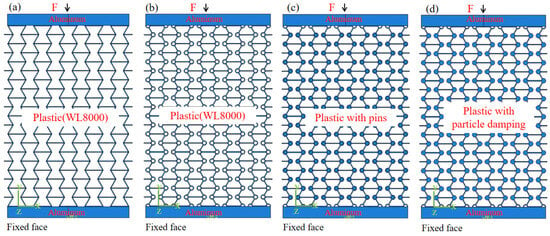
Figure 2.
Diagrammatic of the testing models: (a) T-NPRM, (b) N-NPRM, and (c) N-NPRM with pins. (d) N-NPRM with particle damping.
By solving Equation (1), we obtained the following result:
where R represents the radius of the pin, T denotes the wall thickness of the NPRM, is the density of WL8000, is the density of the pin material, and h represents the thickness of the NPRM plate.
The simulation of the static properties was carried out using the software ABAQUS 2018. For improving the computational efficiency, a 2D model was established, as shown in Figure 2. The element type was CPS4R, and as the thickness of the thin wall was 1.2 mm, in order to ensure the accuracy of the simulation, the maximum size of the element was 0.2 mm. The properties of the materials were set according to Table 2. The bottom aluminum block was fixed, and the force F was loaded on the middle point of the top surface of the top aluminum block.
The compressive testing of the metamaterial structure was performed using a universal testing machine in the configuration shown in Figure 2. The same loading conditions were applied in finite element simulations. The length of the simulated compression curve was set to 20 mm, starting at 0 and gradually increasing in the testing machine. The loading was stopped when the specimen exhibited failure. During the experiments, it was observed that the specimen did not reach the full compression of 20 mm before failure occurred. This behavior can be attributed to the material properties of the metamaterial and the quality of the 3D printing.
A comparison was made between the stress–strain curve obtained from the experiment, where failure did not occur, and the simulated curve, as shown in Figure 3a. The stress–strain curve corresponds to the conventional T-NPRM structure. In Figure 3a, it can be observed that there is good agreement between the experimental and simulated data, confirming the reliability of the simulation method. And in Figure 3a, the figures A~D are the deformation shapes of the metamaterial by simulation and experiment at different strain points.
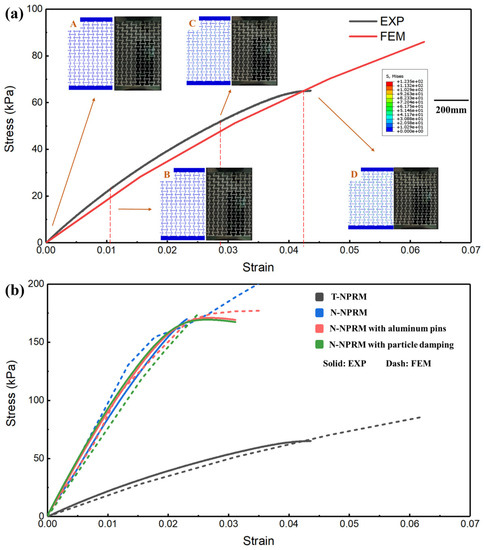
Figure 3.
The stress–strain curve of the metamaterial. (a) T-NPRM, (b) N-NPRM, N-NPRM with aluminum pins, and N-NPRM with particle damping.
Figure 3b displays the stress–strain curves for the traditional T-NPRM, N-NPRM, N-NPRM with aluminum pins, and N-NPRM with particle damping. In the graphs, it can be observed that the addition of circular rings significantly enhanced the stiffness of the NPRM structure, thereby improving the structural load-carrying capacity of the metamaterial. The presence of metal pins increased the local stiffness at the circular ring, but since the compression deformation of the metamaterial structure was primarily governed by the deformation of the connecting walls, there was minimal change in the stress–strain curve.
In the case of N-NPRM with particle damping, a cover was added at the circular ring, with the material of the cover being the same as that of the metamaterial. This slightly increased the stiffness at the circular ring. However, the particles did not have a significant impact on the static mechanical performance of the metamaterial structure, resulting in a minimal difference between the stress–strain curves of the N-NPRM and the N-NPRM with particle damping.
4. Bandgap Properties of N-NPRM
The bandgap is a distinctive property of metamaterials in the field of vibration control. Therefore, in this section, the bandgap performance of T-NPRM and N-NPRM is analyzed to reveal the influence of the design parameters on the bandgap behavior. This work aims to provide a foundation for the bandgap design of the proposed metamaterials.
According to the basic equation of elastic dynamics, without the damping and body force, the propagation of elastic waves in two-dimensional periodic structures can be written as [43]
where is the displacement vector, which is related to the position vector . is a second derivative of the displacement with respect to time. denotes the differential operator, and is the mass density. The symbols and are the Lamé constants, which can represent Young’s modulus and Poisson’s ratio as
According to the Bloch theorem, the displacement vector can be expanded as
where and mean the angular frequency and time, respectively. equals , and is the wave vector of the 2D lattice. The displacement vector is a periodic function with the same periodicity as the periodic structure, which follows the relation
in which is the lattice vector. Combined with Equation (6), and considering the relationship between the node displacement vectors on the cell boundary in the space domain, Equation (5) can be rewritten as
By substituting Equation (7) into Equation (3), the wave−governing equation can be transformed into the eigenvalue equation
where and are the stiffness and mass matrices, respectively. is the displacement column vector of all nodes.
4.1. Bandgap Analysis of the NPRM
In this section, the bandgap performance of the metamaterials is calculated using the multi-physics software COMSOL 5.6. To ensure computational accuracy, the minimum wavelength is generally required to contain 10 elements, and thus, the maximum element size was set as 0.2 mm. Three periodic boundaries were set; the unit cell can be seen in Figure 4a. The properties of the materials were set according to Table 2.
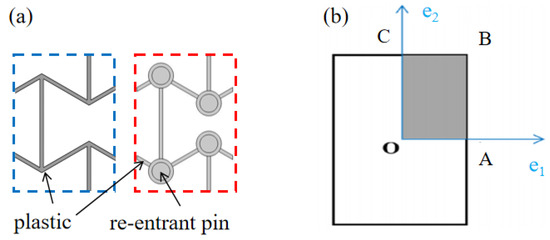
Figure 4.
Bandgap analysis of the metamaterial. (a) Unit cells of the T-NPRM (dotted blue box) and N-NPRM with pins (dotted red box). (b) Brillouin zone of periodic lattices.
The bandgap performances of both T-NPRM and N-NPRM were analyzed to find the factors influencing the distribution and the width of the bandgap. This work will further help in establishing methods for bandgap tuning.
As shown in Figure 4a, the unit cell of the NPRM was used for the bandgap calculations. The Brillouin zone of the periodic lattices, which represents the reciprocal space of the unit cell, is shown in Figure 4b, and the four intersection points are marked by letters O, A, B and C, respectively. The scanning direction follows the path of O-A-B-C-O, corresponding to the scanning parameters 0-1-2-3-4 in COMSOL 5.6.
As shown in Figure 5, the dispersion curves of the traditional T-NPRM, N-NPRM, and N-NPRM with aluminum pins are depicted. Figure 6 illustrates the corresponding mode shapes at specific points. Combining Figure 5 and Figure 6, it can be observed that the T-NPRM structure exhibited a higher bandgap frequency. The dominant mode determining the bandgap width was the deformation of the connecting walls, resulting in a higher starting frequency, such as A1~A4 in Figure 6. Such vibration modes make it challenging to adjust the bandgap width, as changes in the material properties will cause the upper and lower mode frequencies to shift in the same direction. And B1~E4 are the modes corresponding to the marks in Figure 5c. It can be seen that the mode shapes are changed, as the stiffness and mass distribution of the unit cell is changed by the introduction of the rings and pins. The darker the color of the mode shape indicates that the greater the deformation of the corresponding position, and this is not the true deformation amplitude and is only used to represent the deformation shape.
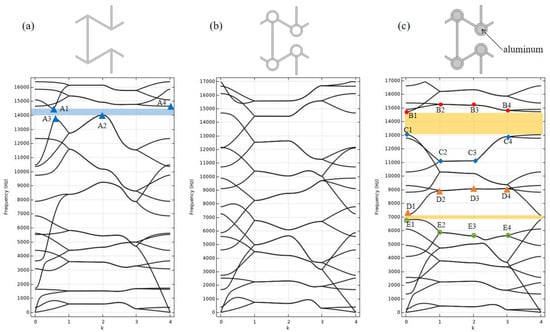
Figure 5.
The dispersion curves of three honeycomb structures. (a) T-NPRM, (b) N-NPRM, (c) N-NPRM with aluminum pins.
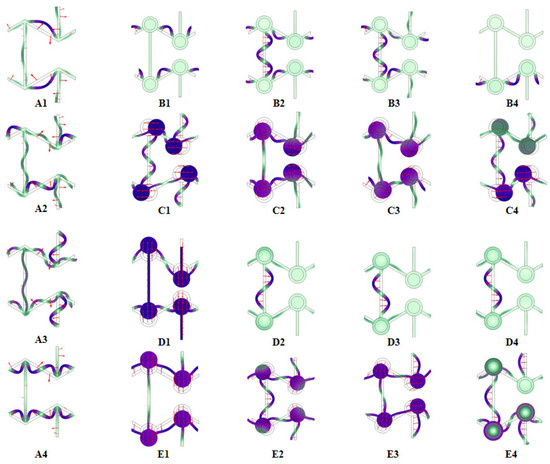
Figure 6.
The vibration modes of the metamaterial corresponding to the points in Figure 5.
For the newly proposed N-NPRM structure, as shown in Figure 5b, the circular rings increased the local stiffness of the unit structure, leading to more coupled modes between the walls and rings. Within the frequency range of the first 20 modes, no bandgap was formed. Introducing the ring at the node mainly increased the stiffness of the node, and the mass change also increased. For the initial cell, the stiffness of the node was larger than that of the thin wall, and as the introduction of the ring resulted in a larger rigid and mass, a slight increase in the mode frequencies was generated. This small and universal change of the dispersion curves did not easily enable them to separate from each other and form bandgaps. As can be seen in Figure 5b, compared to the initial cell, the number of bandgaps reduced from 1 to 0. Therefore, in the design of cell structure, the factors that can bring significant changes to the cell mode must be considered to form the bandgap.
When metal pins were installed in the circular rings, the mass distribution of the N-NPRM cell had a noticeable change. Figure 5c shows that two bandgaps were formed, located near 7000 Hz and 14,000 Hz, respectively. By examining Figure 6, it can be observed that the mode frequencies of D1 and E1 determined the width of the first bandgap. However, both modes are the coupled motion between the walls and pins, and altering the mass of the pins will have an impact on both modes. Therefore, adjusting the material of the assembly pins may not effectively broaden the bandgap width. For the second bandgap, its upper and lower limits were determined by modes B1 and C1, as depicted in Figure 6. It can be noticed that mode B1 represents the localized vibrations of the connecting walls, while mode C1 is the coupled motion between the walls and pins. Thus, by changing the material of the pins, it is possible to conveniently adjust the frequency of mode C1 and consequently control the width of the second bandgap.
Based on the above analysis, it is evident that the bandgap is influenced by different mode shapes. In the vibration design of metamaterials, introducing factors that can alter the mode shapes and frequencies of the unit cell has the potential to control the bandgap of the metamaterial.
4.2. Effects of Design Parameters
Introducing circular rings into the traditional T-NPRM structure can adjust the mode shapes and frequencies of the unit cell, thereby enabling bandgap control of the metamaterial. In this section, we present our research on the influence of the following design factors on the bandgap.
- (1)
- The effects of the materials of assembly pins
Based on the above analysis, it can be observed that to adjust the bandgap of the metamaterial structure, effective control can be achieved by varying the density of the core pins, which requires the use of different materials for the pins. This approach enables the manipulation of the dispersion curves, which are primarily governed by the wall–pin coupled vibration mode, thereby achieving bandgap tuning of the metamaterial. Figure 7 demonstrates the bandgap characteristics of the NPRM using different assembly pin materials, namely WL8000, aluminum, steel, and copper. The bandgaps of the N-NPRM with different pins are marked by blue areas.
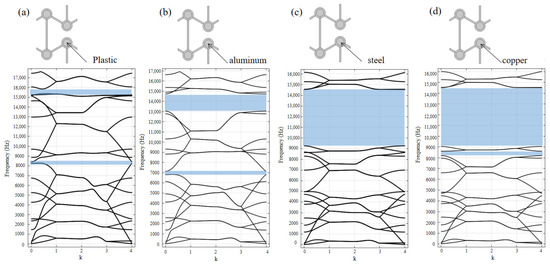
Figure 7.
The dispersion curve of N-NPRM with different pins. (a) N-NPRM with plastic pins, (b) N-NPRM with aluminum pins, (c) N-NPRM with steel pins, (d) N-NPRM with copper pins.
In the figure, it can be observed that the presence of the pins has an impact on the mode frequencies associated with the deformation of the connecting walls. In Figure 7a, where WL8000 is used as the core material, which is the same as the metamaterial, the corresponding mode frequencies of the wall deformation are slightly increased. In the case of Figure 7b–d, the modulus of the metal materials, being significantly higher than that of WL8000, allows the pins to behave as rigid bodies in the deformation mode of the connecting walls (mode B1 in Figure 6). Consequently, the upper frequency of the bandgap (mode B1) remains around 14,700 Hz and does not vary with changes in the pin material. On the other hand, the lower mode shape of the bandgap primarily involves a wall–pin coupled motion. As the density of the pins increases, the corresponding frequency decreases, resulting in an increased width of the bandgap.
As the density difference between steel and copper is not significant, Figure 7c,d shows a minor increase in the width of the frequency band. However, the copper pins induce a decrease in frequency for the other modes, opening up a new bandgap with a frequency range of 8200 Hz to 8600 Hz. It is evident that by utilizing pins of different materials, the width of the bandgap can be effectively adjusted, potentially leading to the formation of new bandgaps.
By using pins made of different materials, the width of the bandgap can be effectively controlled. This provides valuable insights for the bandgap design and optimization of metamaterials. These methods can be used in various applications, such as vibration control, wave manipulation, and energy harvesting, where precise control over bandgaps is desired.
- (2)
- The effect of the size of the pin
From the analysis of the vibration modes above, it can be determined that increasing the size of the pins, without altering the dimensions of the metamaterial unit, will have two main effects. Firstly, reducing the length of the connecting walls will increase the mode frequencies primarily associated with the vibration deformation of the connecting walls. Secondly, increasing the size of the pins will significantly increase the local mass, leading to a decrease in the mode frequencies dominated by the wall–pin coupled motion. The effect of the pin size on the bandgap is illustrated in Figure 8, using steel as the pin material. The bandgaps of N–NPRM with pins radii of 3 mm, 3.5 mm and 4 mm are marked by blue area, red area and yellow area, respectively.
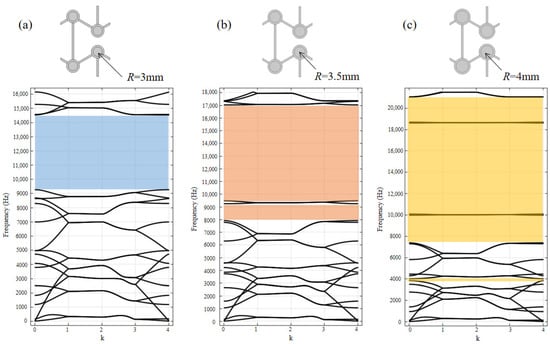
Figure 8.
The effect of pin size on the bandgaps of metamaterials. (a) The pin radius is 3 mm, (b) The pin radius is 3.5 mm, (c) The pin radius is 4 mm.
As the pin size increases, the upper limit frequency of the bandgap increases, while the lower limit frequency decreases, resulting in a significantly widened bandgap. Moreover, when the pin size reaches 4 mm, a new bandgap is opened up in the frequency range of 3800 Hz to 4000 Hz. It can be observed that increasing the pin size is advantageous for expanding the bandgap.
This shows that by adjusting the size of the pins, it is possible to modify the mode frequencies and broaden the bandgap without altering the dimensions of the metamaterial unit. This work provides guidance for the design and optimization of metamaterials with desired bandgap properties, enabling enhanced vibration control and wave manipulation capabilities.
- (3)
- The effect of particle damping
In engineering applications, low–frequency vibration sources often are common. Therefore, low–frequency and wide–band vibration control methods have been a significant research focus. For instance, in traditional industries, like the automotive sector, vibrations below 2000 Hz are of utmost concern. In the context of vibration control in metamaterial structures, bandgap manipulation is an important design approach. In the proposed N-NPRM structure, the addition of circular rings shifts the dispersion curves of the metamaterial towards lower frequencies. However, it remains challenging to form effective bandgaps below 2000 Hz. To expand the application range of metamaterials, new methods must be introduced to suppress vibrations in the low-frequency range.
For the traditional T-NPRM structure, its mode shapes are combinations of the deformations of the walls that make up the structure. In the case of N-NPRM, the addition of circular rings leads to significant changes in the stiffness and mass distribution within the unit cell. The structural stiffness is noticeably increased, which is beneficial for enhancing its load-bearing capacity, as shown in Figure 3. At the same time, the mode shapes of N-NPRM exhibit specific characteristics as the frequency increases, as depicted in Figure 9. The darker the color of the mode shape indicates that the greater the deformation of the corresponding position. For the circular rings, as the frequency increases, they exhibit translational, rotational, and deformation motions, represented by M1 to M3 in Figure 9. At very high frequencies, the mode shapes resemble localized deformations of the walls, as shown by M4 in Figure 9. In the above analysis, it was found that increasing the weight at the location of the circular rings can effectively lower the frequencies of modes, such as M1 to M3.
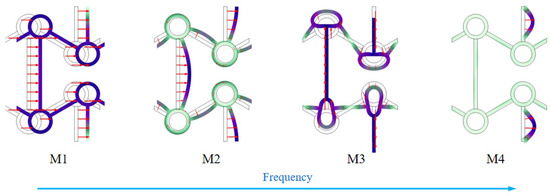
Figure 9.
Mode shapes changing with frequency.
Based on the analysis of the mode shapes of the metamaterial structure shown in Figure 9, it was observed that in the low-frequency range, the circular rings undergo significant motion. Therefore, by combining traditional damping vibration control methods, the introduction of particle damping within the circular rings becomes a possibility for the broad-spectrum suppression of low-frequency vibrations.
In the simulation, the circular rings and particle damping were treated as an integrated system. The increase in weight due to particle damping can be achieved by adjusting the density of the circular rings. To prevent particle leakage, covers were added at both ends of the circular rings, which enhanced the stiffness at the location of the circular rings. The effect on the stiffness can be adjusted by modifying the elastic modulus of the circular rings, disregarding the impact when it is negligible and ensuring equal weight. Figure 10c shows the dispersion diagram of the metamaterial when the weight of the circular rings was equal to the weight of the steel pins. It can be observed in the figure that when particle damping was added within the circular rings, the mode frequencies were generally lower compared to the metamaterial with inserted steel pins since the increase in stiffness due to particle damping was not significant. As shown in Figure 10b,c, the first 20 mode shapes occurred within the frequency ranges of 0–16,000 Hz and 0–9000 Hz, respectively. Although the addition of particles created a bandgap at 6500 Hz, it was still ineffective for controlling the vibrations at even lower frequencies. However, increasing the particle damping caused more dispersion curves to concentrate in the low-frequency range, facilitating the mode of wall-ring–coupled vibrations. This phenomenon allows particles to collide and generate friction, thereby providing damping effects and suppressing vibrations in the low-frequency range.
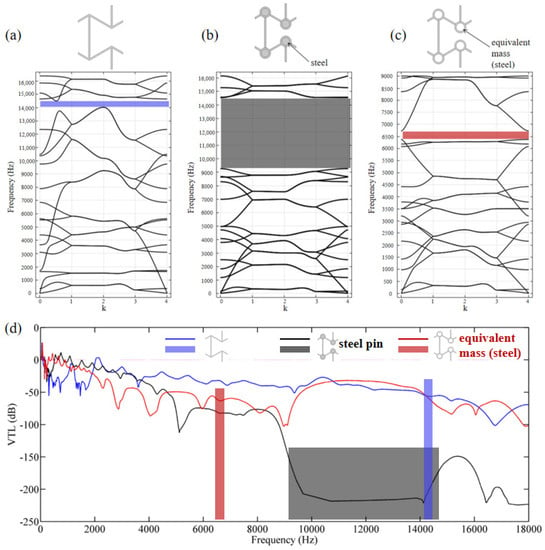
Figure 10.
(a–c) The dispersion curves of three kinds of N-NPRM. (d) The vibration transmission loss of three kinds of N–NPRM.
The vibration suppression ability of the samples was evaluated by the vibration transmission loss (VTL), which can be written as:
where and are the acceleration amplitudes of the sensors shown in Figure 11.
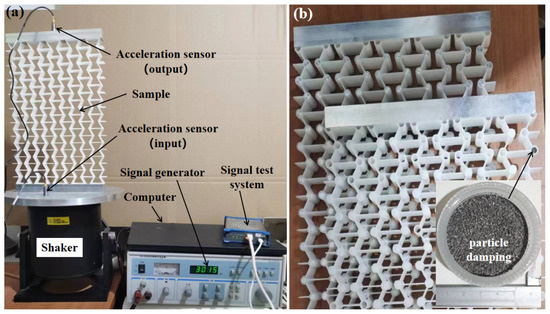
Figure 11.
The testing of vibration transmission loss. (a) The testing system of vibration transmission loss, (b) The metamaterial samples with metal pins and particle damping.
The vibration transmission loss of the NPRMs were calculated by the software ABAQUS, and the results can be seen in Figure 10d. It can be seen that the introduction of steel pins can generate a broad bandgap from 9100 Hz to 14,500 Hz, and the vibration in this frequency band is suppressed obviously. However, compared to the other two NPRMs, the vibration in low frequency (200~4500 Hz) is not suppressed obviously.
The NPRM with equivalent mass can generate a bandgap near 6500 Hz, and the narrow bandgap cannot generate broadband vibration suppression. The equivalent mass cannot obviously increase the stiffness of the NPRM, but it can increase the vibration deformation amplitude, which can enhance the effect of the structure damping. Therefore, the vibration suppression ability in low frequency (400~4500 Hz) is better than the that of the NPRM with steel pins. The steel pin can increase both the mass and stiffness, and thus, the vibration deformation amplitude is weaker than that of the NPRM with an equivalent mass.
In the simulation, for computational efficiency, the particle damping of the equivalent mass was ignored. In the following text, we investigate the vibration suppression ability of particle damping by experiments.
5. Simulation of Transfer Performance and Experimental Verification
In this section, we use simulation and experimental methods to validate the vibrational suppression capability of the proposed N-NPRM and compare the simulations with the experimental results to verify the accuracy of the simulation method. The results show that the simulation agrees well and can effectively guide the design of N-NPRM.
An experimental test of VTL was carried out, as shown in Figure 11a. The sampling frequency of the experiment was 10,000 Hz, and the sampling time was 10 s. A vibration shaker was used to excite the sample. The white noise generated by a sweep signal generator was used as an excitation signal to control the vibration shaker, and the sweeping frequency range was from 1 Hz to 5000 Hz. Two acceleration sensors were used to collect the vibration signal, and the sensitivities were and , respectively. The ultimate testing range of the acceleration sensor was 10,000 Hz.
The results of the simulations and experiments are shown in Figure 12. As can be seen in Figure 12a,b, the frequency consistency corresponding to the structural mode peaks obtained by the simulation and experiment is good (peaks in yellow box), which indicates that the simulation method was effective. Figure 12c shows that the simplified method for N-NPRM with particle damping is feasible, because the frequency consistency corresponding to the simulation and experimental structural mode peaks is good (yellow box), indicating that it was feasible for the stiffness and quality simplification of the particle damping. However, because the action mode of the particle damping was different from the structural damping, the suppression effect of the structural vibration was quite different. Therefore, Figure 12d is an experimental comparison of the vibration suppression effect of N-NPRM with steel pins and N-NPRM with particle damping, and the results show that the particle damping can achieve a very good vibration suppression effect in the low- and middle-frequency bands (peaks in yellow boxes). It is worth noting that particle damping has advantages in the application of the vibration suppression of space equipment due to its good environmental adaptability and high reliability.
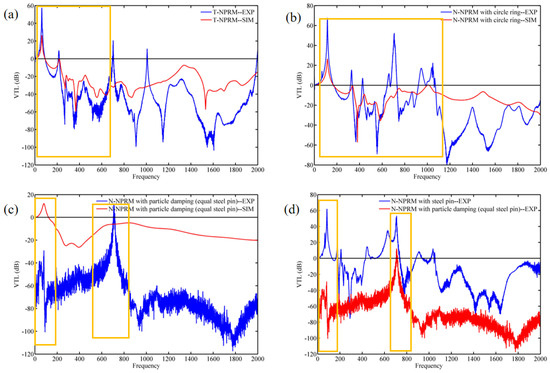
Figure 12.
The vibration transmission loss of different NPRMs. (a) T-NPRM, (b) N-NPRM, (c) N-NPRM with particle damping, (d) N-NPRM with steel and particle damping.
6. Conclusions
In this work, a novel re-entrant NPR metamaterial was designed. Some assembly parts and particle damping were introduced to the proposed metamaterials. The static mechanical properties and vibration suppression capacities were investigated. Some conclusions can be obtained as follows:
- The stiffness of the new NPRM structure is much higher than that of the traditional NPRM structure, which can greatly improve the carrying capacity of the structure to 300%.
- The installation of different metal accessories in N-NPRM can easily adjust the bandgap of metamaterials. The larger the re-entrant ring, the wider the bandgap.
- Mounting particle damping in N-NPRM enables very good vibration inhibition in the medium- and low-frequency bands.
The re-entrant metamaterial proposed in this paper can easily change its bandgap characteristics by replacing the assembly pin. Particle damping has good environmental adaptability and high reliability, and its introduction is conducive to extending the vibration suppression application of metamaterials in space equipment.
Author Contributions
Conceptualization, X.G. and Z.W.; methodology, Z.W.; validation, J.W. and J.H.; formal analysis, Y.L.; investigation, J.W. and Z.W.; resources, Y.L.; data curation, X.G.; writing—original draft preparation, Z.W.; writing—review and editing, Z.W. and Y.L.; visualization, X.G.; supervision, J.H.; project administration, X.G. All authors have read and agreed to the published version of the manuscript.
Funding
This research received no external funding.
Institutional Review Board Statement
Not applicable.
Informed Consent Statement
Not applicable.
Data Availability Statement
If required, please contact the corresponding author by email.
Conflicts of Interest
The authors declare no conflict of interest.
References
- Mizzi, L.; Attard, D.; Gatt, R.; Farrugia, P.S.; Grima, J.N. An analytical and finite element study on the mechanical properties of irregular hexachiral honeycombs. Smart Mater. Struct. 2018, 27, 105016. [Google Scholar]
- Gatt, R.; Attard, D.; Farrugia, P.S.; Azzopardi, K.M.; Mizzi, L.; Brincat, J.P.; Grima, J.N. A realistic generic model for anti-tetrachiral systems. Phys. Status Solidi B-Basic Solid State Physic 2013, 250, 2012–2019. [Google Scholar] [CrossRef]
- Lew, T.L.; Spadoni, A.; Scarpa, F.; Ruzzene, M. Chiral hexagonal cellular sandwich structure: A vibro-acoustic assessment. In Smart Structures and Materials 2005: Damping and Isolation; SPIE: Bellingham, WA, USA, 2005; Volume 5760, pp. 559–568. [Google Scholar]
- Spadoni, A.; Ruzzene, M.; Scarpa, F. Dynamic response of chiral truss-core assemblies. J. Intell. Mater. Syst. Struct. 2006, 17, 941–952. [Google Scholar]
- Spadoni, A.; Ruzzene, M. Structural and acoustic behavior of chiral truss-core beams. World Acad. Sci. Eng. Technol. 2006, 128, 616–626. [Google Scholar] [CrossRef]
- Spadoni, A.; Ruzzene, M.; Gonella, S.; Scarpa, F. Phononic properties of hexagonal chiral lattices. Wave Motion 2019, 46, 435–450. [Google Scholar] [CrossRef]
- Niu, X.; Hu, X.; Yan, Q.; Zhu, J.; Cheng, H.; Huang, Y.; Lu, C.; Fu, Y.; Gong, Q. Plasmon-Induced Transparency Effect for Ultracompact On-Chip Devices. Nanophotonics 2019, 8, 1125–1149. [Google Scholar]
- Zhu, L.; Dong, L. Electromagnetically Induced Transparency Metamaterials: Theories, Designs and Applications. J. Phys. D Appl Phys. 2022, 55, 263003. [Google Scholar]
- Zhang, X.G.; Ren, X.; Jiang, W.; Zhang, X.Y.; Luo, C.; Zhang, Y.; Xie, Y.M. A novel auxetic chiral lattice composite: Experimental and numerical study. Compos. Struct. 2022, 282, 115043. [Google Scholar]
- Gao, Q.; Ding, Z.; Liao, W. Effective elastic properties of irregular auxetic structures. Compos. Struct. 2022, 287, 115269. [Google Scholar]
- Luo, H.C.; Ren, X.; Zhang, Y.; Zhang, X.Y.; Zhang, X.G.; Luo, C.; Cheng, X.; Xie, Y.M. Mechanical properties of foam-filled hexagonal and re-entrant honeycombs under uniaxial compression. Compos. Struct. 2022, 280, 114922. [Google Scholar]
- Luo, C.; Han, C.Z.; Zhang, X.Y.; Zhang, X.G.; Ren, X.; Xie, Y.M. Design, manufacturing and applications of auxetic tubular structures: A review. Thin-Walled Struct. 2021, 163, 107682. [Google Scholar]
- Tan, H.L.; He, Z.C.; Li, K.X.; Li, E.; Cheng, A.G.; Xu, B. In-plane crashworthiness of reentrant hierarchical honeycombs with negative Poisson’s ratio. Compos. Struct. 2019, 229, 111415. [Google Scholar]
- Zhou, Z.X.; Zhou, J.N.; Fan, H.L. Plastic analyses of thin-walled steel honeycombs with re-entrant deformation style. Mat. Sci. Eng. A Struct. 2017, 688, 123–133. [Google Scholar] [CrossRef]
- Zhang, X.C.; An, C.C.; Shen, Z.F.; Wu, H.X.; Yang, W.G.; Bai, J.P. Dynamic crushing responses of bio-inspired re-entrant auxetic honeycombs under in-plane impact loading. Mater. Today Commun. 2020, 23, 100918. [Google Scholar]
- Tan, X.; Chen, S.; Wang, B.; Tang, J.; Wang, L.; Zhu, S.; Yao, K.; Xu, P. Real-time tunable negative stiffness mechanical metamaterial. Extreme Mech. Lett. 2020, 41, 100990. [Google Scholar]
- Chen, X.; Zhao, J.L.; Deng, J.; Jing, Y.; Pu, H.Y.; Luo, J. Low-frequency enhancement of acoustic black holes via negative stiffness supporting. Inter. J. Mech. Sci. 2023, 241, 107921. [Google Scholar]
- Chen, B.; Chen, L.; Du, B.; Liu, H.; Li, W.; Fang, D. Novel multifunctional negative stiffness mechanical metamaterial structure: Tailored functions of multi-stable and compressive mono-stable. Compos. Part B Eng. 2020, 204, 108501. [Google Scholar]
- Li, Q.; Yang, D.Q.; Ren, C.H.; Mao, X. A systematic group of multidirectional buckling-based negative stiffness metamaterials. Inter. J. Mech. Sci. 2022, 232, 107611. [Google Scholar]
- Tan, X.J.; Wang, B.; Chen, S.; Zhu, S.W.; Sun, Y.G. A novel cylindrical negative stiffness structure for shock isolation. Compos. Struct. 2019, 214, 379–405. [Google Scholar]
- Yu, H.B.; Wu, W.W.; Zhang, J.X.; Chen, J.K.; Liao, H.T.; Fang, D.L. Drastic tailorable thermal expansion chiral planar and cylindrical shell structures explored with finite element simulation. Compos. Struct. 2019, 210, 327–338. [Google Scholar]
- Li, X.; Gao, L.B.; Zhou, W.Z.; Wang, Y.J.; Lu, Y. Novel 2D metamaterials with negative Poisson’s ratio and negative thermal expansion. Extreme Mech. Lett. 2019, 30, 100498. [Google Scholar]
- Liu, H.T.; Xu, N.; Wang, Y.B.; Wang, L. Three-dimensional enhanced star-shaped honeycombs with negative thermal expansion. Compos. Struct. 2022, 279, 114772. [Google Scholar] [CrossRef]
- Zhang, L.W.; Bai, Z.H.; Chen, Y.F. Dual-functional hierarchical mechanical metamaterial for vibration insulation and energy absorption. Eng. Struct. 2022, 271, 114916. [Google Scholar]
- Li, X.; Yu, X.; Chua, J.W.; Lee, H.P.; Ding, J.; Zhai, W. Microlattice metamaterials with simultaneous superior acoustic and mechanical energy absorption. Small 2021, 17, 2100336. [Google Scholar]
- Chen, L.M.; Zhang, J.; Du, B.; Zhou, H.; Liu, H.C.; Guo, Y.G.; Li, W.; Fang, D. Dynamic crushing behavior and energy absorption of graded lattice cylindrical structure under axial impact load. Thin-Walled Struct. 2018, 127, 333–343. [Google Scholar]
- Guo, Y.G.; Zhang, J.; Chen, L.M.; Du, B.; Liu, H.C.; Chen, L.L.; Li, W.; Liu, Y. Deformation behaviors and energy absorption of auxetic lattice cylindrical structures under axial crushing load. Aerosp. Sci. Technol. 2020, 98, 105662. [Google Scholar]
- Moeini, M.; Begon, M.; Lévesque, M. Numerical homogenization of a linearly elastic honeycomb lattice structure and comparison with analytical and experimental results. Mech. Mater. 2022, 167, 104210. [Google Scholar]
- Moscatelli, M.; Ardito, R.; Driemeier, L.; Comi, C. Band-gap structure in twoand three-dimensional cellular locally resonant materials. J. Sound Vib. 2019, 454, 73–84. [Google Scholar]
- Meng, J.; Deng, Z.; Zhang, K.; Xu, X.; Wen, F. Band gap analysis of star-shaped honeycombs with varied Poisson’s ratio. Smart Mater. Struct. 2015, 24, 095011. [Google Scholar]
- Mukherjee, S.; Scarpa, F.; Gopalakrishnan, S. Phononic band gap design in honeycomb lattice with combinations of auxetic and conventional core. Smart Mater. Struct. 2016, 25, 054011. [Google Scholar] [CrossRef]
- Li, H.; Liu, H.; Zou, J. Minnaert resonances for bubbles in soft elastic materials. SIAM J. Appl. Math. 2022, 82, 119–141. [Google Scholar] [CrossRef]
- Nitish, K.; Siladitya, P. Low frequency and wide band gap metamaterial with divergent shaped star units: Numerical and experimental investigations. Appl. Phys. Lett. 2019, 115, 254101. [Google Scholar]
- Wang, Y.F.; Wang, Y.Z.; Wu, B. Tunable and Active Phononic Crystals and Metamaterials. Appl. Mech. Rev. 2020, 72, 040801. [Google Scholar] [CrossRef]
- Atul, K.S.; Majd, K.; Gal, S.; Oded, A. Gradient-based topology optimization of soft dielectrics as tunable phononic crystals. Compos. Struct. 2022, 280, 114846. [Google Scholar]
- Zeeshan, A.; Srikant, P.; Atul, K.S. Magnetically tunable longitudinal wave band gaps in hard-magnetic soft laminates. Int. J. Mech. Sci. 2023, 249, 108262. [Google Scholar]
- Alam, Z.; Sharma, A.K. Functionally Graded Soft Dielectric Elastomer Phononic Crystals: Finite Deformation, Electro-Elastic Longitudinal Waves, and Band Gaps Tunability via Electro-Mechanical Loading. Int. J. Appl. Mech. 2022, 14, 2250050. [Google Scholar] [CrossRef]
- Khajeh-Khalili, F.; Honarvar, M.A. Novel Tunable Peace-Logo Planar Metamaterial Unit-Cell for Millimeter-Wave Applications. ETRI J. 2018, 40, 389–395. [Google Scholar] [CrossRef]
- Khajeh-Khalili, F.; Honarvar, M.A.; Limiti, E. A Novel High-Isolation Resistor-Less Millimeter-Wave Power Divider Based on Metamaterial Structures for 5G Applications. IEEE Trans. Compon. Packag. Manuf. Technol. 2021, 11, 294–301. [Google Scholar] [CrossRef]
- Khajeh-Khalili, F.; Honarvar, M.A.; Naser-Moghadasi, M.; Dolatshahi, M. Gain enhancement and mutual coupling reduction of multiple-intput multiple-output antenna for millimeter-wave applications using two types of novel metamaterial structures. Int. J. RF Microw. Comput. Eng. 2020, 30, 22006. [Google Scholar] [CrossRef]
- Liang, K.; Wang, Y.; Luo, Y.; Takezawa, A.; Zhang, X.; Kang, Z. Programmable and multistable metamaterials made of precisely tailored bistable cells. Mater. Des. 2023, 227, 111810. [Google Scholar] [CrossRef]
- Ramachandran, T.; Faruque, M.R.I.; Singh, M.S.J.; Al-Mugren, K.S. Compact Multi-Layered Symmetric Metamaterial Design Structure for Microwave Frequency Applications. Materials 2023, 16, 4566. [Google Scholar] [CrossRef] [PubMed]
- Ma, N.; Han, Q.; Han, S.; Li, C. Hierarchical re-entrant honeycomb metamaterial for energy absorption and vibration insulation. Int. J. Mech. Sci. 2023, 250, 108307. [Google Scholar] [CrossRef]
Disclaimer/Publisher’s Note: The statements, opinions and data contained in all publications are solely those of the individual author(s) and contributor(s) and not of MDPI and/or the editor(s). MDPI and/or the editor(s) disclaim responsibility for any injury to people or property resulting from any ideas, methods, instructions or products referred to in the content. |
© 2023 by the authors. Licensee MDPI, Basel, Switzerland. This article is an open access article distributed under the terms and conditions of the Creative Commons Attribution (CC BY) license (https://creativecommons.org/licenses/by/4.0/).